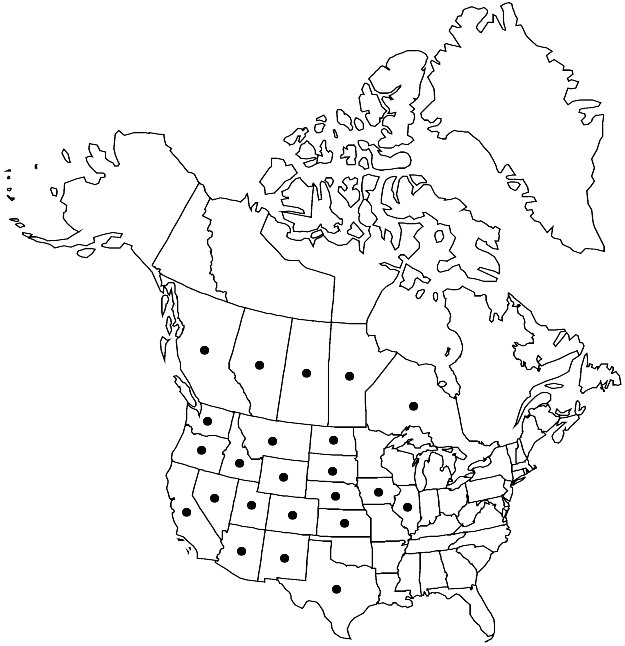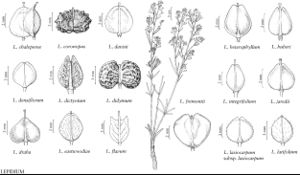Difference between revisions of "Lepidium chalepense"
Cent. Pl. II, 23. 1756.
FNA>Volume Importer |
imported>Volume Importer |
||
| Line 59: | Line 59: | ||
|elevation=300-4200 m | |elevation=300-4200 m | ||
|distribution=Alta.;B.C.;Man.;Ont.;Sask.;Ariz.;Calif.;Colo.;Idaho;Ill.;Iowa;Kans.;Mont.;Nebr.;Nev.;N.Mex.;N.Dak.;Oreg.;S.Dak.;Tex.;Utah;Wash.;Wyo.;Asia;introduced also in South America (Argentina);Europe. | |distribution=Alta.;B.C.;Man.;Ont.;Sask.;Ariz.;Calif.;Colo.;Idaho;Ill.;Iowa;Kans.;Mont.;Nebr.;Nev.;N.Mex.;N.Dak.;Oreg.;S.Dak.;Tex.;Utah;Wash.;Wyo.;Asia;introduced also in South America (Argentina);Europe. | ||
| + | |introduced=true | ||
|discussion=<p>From the synonymy above, it is evident that the disposition of <i>Lepidium chalepense</i> has varied: more than one species (e.g., R. C. Rollins 1940; G. A. Mulligan and C. Frankton 1962), one species (e.g., Rollins 1993), a variety of <i>Lepidium</i> (Cardaria) draba (N. H. Holmgren 2005b), or a synonym of the latter species (C. L. Hitchcock 1936). In our opinion, the differences in fruit morphology and chromosome number justify its recognition as a distinct species.</p> | |discussion=<p>From the synonymy above, it is evident that the disposition of <i>Lepidium chalepense</i> has varied: more than one species (e.g., R. C. Rollins 1940; G. A. Mulligan and C. Frankton 1962), one species (e.g., Rollins 1993), a variety of <i>Lepidium</i> (Cardaria) draba (N. H. Holmgren 2005b), or a synonym of the latter species (C. L. Hitchcock 1936). In our opinion, the differences in fruit morphology and chromosome number justify its recognition as a distinct species.</p> | ||
|tables= | |tables= | ||
| Line 83: | Line 84: | ||
|publication year=1756 | |publication year=1756 | ||
|special status= | |special status= | ||
| − | |source xml=https:// | + | |source xml=https://bibilujan@bitbucket.org/aafc-mbb/fna-data-curation.git/src/bb6b7e3a7de7d3b7888a1ad48c7fd8f5c722d8d6/coarse_grained_fna_xml/V7/V7_929.xml |
|tribe=Brassicaceae tribe Lepidieae | |tribe=Brassicaceae tribe Lepidieae | ||
|genus=Lepidium | |genus=Lepidium | ||
Revision as of 00:02, 28 May 2020
Perennials; (rhizomatous); densely hirsute to glabrate or glabrous. Stems several from base, erect or decumbent basally, branched (several) distally, (0.8–)2.1–6.6(–9.2) dm. Basal leaves (early withered); not rosulate; petiole 0.9–4.4 cm; blade obovate, spatulate, or ovate, (1.8–)2.5–8.6(–14) cm × 10–37 mm, margins subentire or dentate. Cauline leaves sessile; blade obovate to oblong or lanceolate to oblanceolate, (1.5–)2.6–9.3(–13.2) cm × (7–)12–31(–45) mm, base sagittate-amplexicaul or auriculate, margins dentate or entire, (surfaces pubescent or glabrous). Racemes (corymbose panicles), elongated in fruit; rachis glabrous or puberulent, trichomes cylindrical, straight or curved. Fruiting pedicels ascending to horizontal, straight, (terete), 5–16(–19) × 0.2–0.3 mm, glabrous or sparsely puberulent adaxially. Flowers: sepals oblong to ovate, 1.7–3 × 1–1.6 mm; petals white, obovate, 3–5 × 1.2–2.4 mm, claw 1.2–2 mm; stamens 6; filaments 2–3.3 mm, (glabrous); anthers 0.5–0.6 mm. Fruits (indehiscent), obovoid to subglobose or obcompressed globose, 3.5–5.8(–7) × (3.5–)4–6.2(–7) mm, apically not winged, apical notch absent; valves thin, smooth, often not veined, glabrous; style (0.8–)1.2–2(–2.3) mm. Seeds (dark reddish brown), ovate, 1.5–2.3 × 1–1.3 mm. 2n = 48, 80, 128.
Phenology: Flowering May–Jun.
Habitat: Mountain slopes, roadsides, fields, agricultural lands, stream banks, pastures, waste areas
Elevation: 300-4200 m
Distribution

Introduced; Alta., B.C., Man., Ont., Sask., Ariz., Calif., Colo., Idaho, Ill., Iowa, Kans., Mont., Nebr., Nev., N.Mex., N.Dak., Oreg., S.Dak., Tex., Utah, Wash., Wyo., Asia, introduced also in South America (Argentina), Europe.
Discussion
From the synonymy above, it is evident that the disposition of Lepidium chalepense has varied: more than one species (e.g., R. C. Rollins 1940; G. A. Mulligan and C. Frankton 1962), one species (e.g., Rollins 1993), a variety of Lepidium (Cardaria) draba (N. H. Holmgren 2005b), or a synonym of the latter species (C. L. Hitchcock 1936). In our opinion, the differences in fruit morphology and chromosome number justify its recognition as a distinct species.
Selected References
None.
